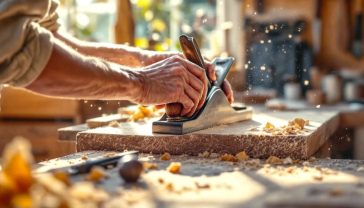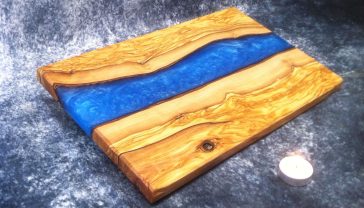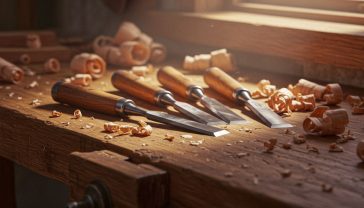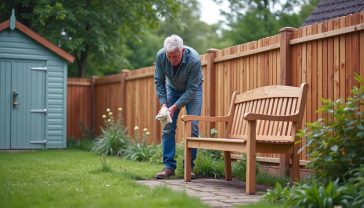Woven Fabrics Uncovered: Techniques, Patterns, and Surprising Uses
An ultimate guide to woven fabrics for a UK audience. Explore plain, twill, and satin weaves, iconic patterns like herringbone, and their surprising modern uses.

This post may contain affiliate links. If you make a purchase through these links, we may earn a commission at no additional cost to you.
From the scratchy wool of a school blazer to the soft linen of a summer tea towel, woven fabrics are all around us. They’re so common, in fact, that we barely give them a second thought. But behind every shirt, sofa, and pair of jeans is a story that stretches back thousands of years—a tale of threads, looms, and incredible human ingenuity.
This isn’t just a story about how things are made. It’s a story about Britain. It’s woven into the very fabric of our history, from the smoke-stack mills of Manchester that powered an empire to the distinctive tartan patterns that define the Scottish Highlands. We’re going to unravel this story, thread by thread. We’ll look at how a simple criss-cross of yarns creates everything from delicate silk to tough-as-nails denim. We’ll discover the secrets behind patterns like herringbone and houndstooth, and we’ll even see how woven materials are being used in places you’d never expect—like inside a jet engine.
So, grab a cuppa and get comfortable. It’s time to uncover the fascinating world of woven fabrics.
The ABCs of Weaving: What Makes a Fabric ‘Woven’?
Before we dive into the deep end, let’s get the basics sorted. What does ‘woven’ actually mean? It sounds simple, but it’s a specific technique that gives fabrics their unique character.
Imagine you’re making a lattice top for a pie. You lay down strips of pastry in one direction, and then you weave other strips over and under them in the opposite direction. That’s pretty much exactly how weaving works.
At its heart, weaving is the art of interlacing two sets of threads at right angles to create a stable piece of cloth. It’s a beautifully simple idea that has been refined over millennia.
Warp and Weft: The Two Threads That Rule Them All
Every woven fabric is made from two sets of threads. Get your head around these, and you’ve cracked the code of weaving.
- The Warp: These are the threads that run lengthwise down the fabric. They are held tight and under tension on a frame or a machine called a loom. Think of them as the strong, straight backbone of the cloth. You can remember it like this: the warp threads go from top to bottom, just like a waterfall goes down.
- The Weft: These are the threads that travel from side to side, weaving over and under the warp threads. The weft is the thread that does all the fancy work, creating the pattern and filling out the fabric. It’s sometimes called the ‘fill’ thread.
It’s the precise way the weft thread passes over and under the warp threads that determines everything about the fabric: its strength, its texture, its drape, and its pattern. Change the sequence, and you change the fabric entirely.
The Loom: From Simple Frames to Industrial Giants
You can’t talk about weaving without talking about the loom. A loom is any device that holds the warp threads in place, allowing the weft to be interlaced. Looms can be incredibly simple or mind-bogglingly complex.
- Ancient Looms: The earliest looms were little more than a pair of sticks holding a set of warp threads, with the weaver painstakingly passing the weft through by hand. You can still find simple frame looms used by hobbyists today.
- The Power Loom: The real game-changer was the invention of the power loom during the Industrial Revolution. Edmund Cartwright, a clergyman from Nottinghamshire, patented the first version in 1785. His machine, and the ones that followed, used water or steam power to weave cloth at a speed that was impossible for a human to match. This invention transformed Britain, leading to the rise of textile mills across the North of England and forever changing how clothes were made. These machines took weaving from a cottage industry to the heart of the global economy.
Today, industrial looms are incredible pieces of engineering. Computer-controlled machines can weave thousands of weft threads per minute, creating complex patterns with pinpoint accuracy. Yet, the fundamental principle of interlocking warp and weft remains exactly the same as it was thousands of years ago.
The Three Musketeers of Weaving: Plain, Twill, and Satin
Almost every woven fabric you’ve ever touched is based on one of three fundamental weaving techniques, known as weaves. These are the building blocks from which all other patterns are made.
Think of them like the primary colours of weaving. By mixing and matching them, you can create an almost infinite variety of textures and designs.
Plain Weave: The Simple, Sturdy Workhorse
This is the most basic and common weave of all. The weft thread goes over one warp thread, then under the next, over the one after that, and so on. It creates a simple, strong checkerboard pattern.
- Simplified Explanation: Imagine a chessboard. That tight, interlocking grid is what a plain weave looks like up close.
- Detailed Explanation: The weft thread passes over and under single warp threads in an alternating sequence (over 1, under 1). On the next row, the pattern is reversed. This creates the maximum number of interlacing points, which makes the fabric very strong and durable, but also a bit stiff.
- Examples You’ll Know:
- Cotton Poplin: The crisp fabric used for school shirts and men’s formal shirts.
- Gingham: That classic checked pattern used for summer dresses and tablecloths.
- Taffeta: A smooth, crisp fabric often used for fancy evening gowns.
- Muslin: A lightweight, breathable cotton fabric used for everything from dressmaking patterns to baby cloths.
Plain weave is cheap to produce and incredibly versatile, which is why it’s everywhere. It’s the reliable Ford Fiesta of the fabric world.
Twill Weave: The Diagonal Dynamo
If you’ve ever worn a pair of jeans, you know twill weave. This is the one that creates a distinctive diagonal pattern on the surface of the fabric.
- Simplified Explanation: Instead of a simple checkerboard, twill has a pattern of diagonal parallel ribs. It’s what gives denim its classic look.
- Detailed Explanation: In a twill weave, the weft thread floats over two or more warp threads, then under one or more, with the sequence stepping over by one warp thread on each row. For example, it might go over two, under one. This “step” creates the diagonal line. Because there are fewer interlacing points than in a plain weave, the fabric is more flexible, drapes better, and is less prone to wrinkling.
- Examples You’ll Know:
- Denim: The king of twills. The diagonal lines are very easy to see. Traditionally, the warp thread is dyed indigo (blue) and the weft is left white, which is why the underside of your jeans is lighter than the outside.
- Herringbone: A classic pattern used in tweed jackets and smart coats, where the diagonal reverses at regular intervals to create a V-shape, like the skeleton of a herring.
- Houndstooth: Another iconic pattern made with a broken twill weave, often found on jackets and skirts.
- Gabardine: A tightly woven twill invented by Thomas Burberry in 1879. Its density made it water-resistant, and it was famously used to make trench coats for British officers in the First World War.
Twill weaves are fantastic for trousers, jackets, and upholstery because they are durable and hide stains well.
Satin Weave: The Luxurious Show-Off
This is the weave that creates a fabric with a gorgeously smooth, shiny, and luxurious surface. When you think of satin, you think of elegance and glamour.
- Simplified Explanation: Satin is all about creating a smooth surface by having one set of threads ‘float’ over the others, which allows them to catch the light and shine.
- Detailed Explanation: A satin weave is created by having the weft thread float over four or more warp threads (e.g., over 4, under 1). These interlacing points are arranged to be as far apart as possible, so they don’t form a visible diagonal line like in a twill. This long float is what creates the lustrous surface. However, it also means the fabric is more delicate and can snag easily.
- A Quick Note on Terminology: Technically, if the fabric is made from silk, it’s called satin. If it’s made from another fibre like cotton or polyester, it’s called sateen. But in everyday chat, people often just say satin for both.
- Examples You’ll Know:
- Satin Dresses: The go-to for bridesmaid dresses and formal evening wear.
- Lining in Jackets: The smooth, slippery fabric inside a smart jacket is often a satin weave, making it easy to slip on and off.
- Luxurious Bedding: Sateen sheets have a wonderfully soft and smooth feel.
While beautiful, satin is the high-maintenance one of the trio. It snags easily and isn’t as durable as plain or twill weaves, so it’s usually saved for special occasions or items that don’t see a lot of wear and tear.
A Tapestry of Time: How Weaving Shaped Britain
The story of weaving in Britain isn’t just about cloth; it’s about people, power, and progress. From ancient Celtic patterns to the engine rooms of the Industrial Revolution, fabric has been at the very centre of our national story.
Ancient Roots: Wool, Woad, and Early Weavers
Long before the Romans arrived, the people of Britain were spinning wool and weaving it into practical, warm clothing. Archaeologists have found evidence of simple looms dating back to the Bronze Age. The Celts were renowned for their love of bright colours and checked patterns, using dyes made from plants like woad to create vibrant blues. This was the very beginning of a long love affair with patterned cloth.
For centuries, weaving was a domestic chore, done by families in their own homes to make cloth for themselves. But by the Middle Ages, it was becoming a serious trade. Wool was Britain’s most important export. So much so that even today, the Lord Speaker in the House of Lords sits on the Woolsack, a large wool-stuffed cushion, as a symbol of the nation’s historic wealth built on the wool trade.
The Industrial Revolution: Mills, Steam, and the North
If there’s one period where weaving truly defined Britain, it’s the Industrial Revolution. The late 18th and 19th centuries saw a seismic shift. Inventions like the spinning jenny, the water frame, and of course, Cartwright’s power loom, mechanised textile production.
This was the birth of the factory. Huge, multi-storey mills sprang up across Lancashire and Yorkshire, powered first by water wheels and then by mighty steam engines. Towns like Manchester, Leeds, and Bradford became global centres of textile manufacturing. Manchester was even nicknamed “Cottonopolis” because of the sheer volume of cotton fabric it produced, much of it from raw cotton picked by enslaved people in the American South.
This era had a profound social impact. People flocked from the countryside to work in the mills, creating Britain’s first industrial cities. Working conditions were often brutal—long hours, dangerous machinery, and choking dust. But it also powered the British Empire, created immense wealth, and laid the foundations for the modern world. The echoes of this era can still be seen in the grand Victorian architecture of our northern cities and the canals that once carried raw materials and finished cloth across the country.
Iconic British Fabrics: A Pattern for Every Place
Over the centuries, certain regions of Britain became famous for producing specific types of woven fabric. These materials are more than just textiles; they are symbols of local identity and craftsmanship.
- Tweed and Tartan (Scotland): You can’t think of Scottish fabric without thinking of tartan, the iconic criss-cross patterns associated with different clans. Originally woven from wool, each pattern, or sett, identified a family or region. A bit further south, in the Outer Hebrides, you’ll find Harris Tweed. This is a very special case. To be legally called Harris Tweed, the fabric must be hand-woven by islanders in their homes on the Isles of Harris, Lewis, Uist, and Barra, using pure virgin wool that has been dyed and spun in the Outer Hebrides. It’s a protected craft and a symbol of enduring quality.
- The Woollens of Yorkshire: For centuries, the towns of West Yorkshire, like Huddersfield and Bradford, were world-renowned for producing the finest woollen and worsted cloths. A worsted fabric is made from long, fine wool fibres that are combed to lie parallel, creating a smooth, strong yarn perfect for making sharp suits. Many of the famous Savile Row tailors in London still source their cloth from these historic Yorkshire mills.
- Linen from Northern Ireland: For a long time, Northern Ireland was a global powerhouse in linen production. The damp climate was perfect for growing the flax plant, from which linen fibres are derived. Irish linen was prized for its fine quality and was used for everything from handkerchiefs to high-quality tablecloths. While the industry is much smaller today, the reputation for quality remains.
These fabrics are a living link to our past, reminders of a time when what you wore was deeply connected to where you were from.
Beyond the Big Three: Exploring More Complex Weaves
While plain, twill, and satin are the foundations, weavers have developed countless other techniques to create fabrics with unique textures and properties. Here are a few you might come across.
Pile Weaves: Creating a 3D Surface
Pile weaves are all about creating a fabric that isn’t flat. They have an extra set of threads that are pulled up into loops on the surface. These loops can either be left as they are or cut.
- Examples You’ll Know:
- Velvet: This is the ultimate luxury pile fabric. An extra set of warp threads is woven in, forming loops that are then cut to create a dense, soft, and plush surface. It’s famously difficult to make, which is why it was historically reserved for royalty and the very rich.
- Corduroy: Think of corduroy as the practical, everyday cousin of velvet. It’s a pile fabric, usually made from cotton, where the cut pile is arranged in distinct vertical lines called ‘wales’. The width of the wales can vary, from thick ‘jumbo cord’ to very fine ‘needlecord’.
- Towelling: The fabric your bath towels are made from is a pile weave where the loops are left uncut. These loops are what make the towel so absorbent, as they dramatically increase the surface area of the cloth.
Jacquard Weave: Weaving Pictures with Thread
This is where weaving gets really clever. The Jacquard loom, invented by Joseph Marie Jacquard in France in 1804, was a revolutionary piece of technology. It used a series of punched cards—a bit like an early computer program—to control which individual warp threads were lifted for each pass of the weft.
- Simplified Explanation: A Jacquard loom allows you to ‘paint with thread’, creating incredibly complex patterns like flowers, scrolls, or even images, directly into the fabric itself.
- Detailed Explanation: Each hole on a punch card corresponded to a single warp thread. This system allowed for the creation of intricate, non-repeating designs that were impossible to achieve on a standard loom. It was one of the earliest examples of a programmable machine and is even considered a forerunner to modern computing.
- Examples You’ll Know:
- Brocade: A rich, decorative fabric with a raised pattern, often featuring floral or elaborate designs in contrasting colours or metallic threads. It’s frequently used for fancy evening wear and upholstery.
- Damask: Similar to brocade, but the pattern is created by contrasting satin and matte weaves. A classic example is a formal white linen tablecloth with a subtle, self-coloured pattern that you can only see when the light catches it just right.
Dobby Weave: The Simpler Pattern-Maker
A dobby weave is a bit like a simplified version of a Jacquard. It’s used to create small, geometric patterns that repeat regularly.
- Simplified Explanation: If Jacquard is for painting a detailed picture, dobby is for creating a repeating wallpaper pattern.
- Detailed Explanation: A dobby loom uses a device called a ‘dobby’ to control a smaller number of warp threads than a Jacquard. This makes it perfect for creating simple textures and geometric figures.
- Examples You’ll Know:
- Piqué: This fabric, often used for polo shirts (think Fred Perry), has a fine, raised geometric pattern, like a waffle or honeycomb texture.
- Bird’s Eye: A fabric with a small, repeating pattern that resembles a bird’s eye. It’s often used for smart men’s shirting.
Weaving in the 21st Century: Surprising Modern Uses
You might think of weaving as an ancient craft, but it is still at the cutting edge of technology. The ability to create strong, stable, and precisely engineered structures from threads means that woven fabrics are being used in some truly astonishing ways.
Technical Textiles: The Unseen Super-Fabrics
This is a huge and growing field. Technical textiles are materials engineered for function, not fashion. They are designed to be incredibly strong, lightweight, and resistant to heat or chemicals.
- Carbon Fibre: This is one of the most famous examples. It’s not just one material; it’s a composite. It starts with a woven fabric made from ultra-thin strands of carbon. This fabric is then set in a hard resin (a type of plastic). The weave of the carbon fabric provides the strength and structure, while the resin holds it all together. The result is a material that is stronger than steel but much, much lighter. It’s used everywhere:
- In Formula 1 cars to protect the driver in a crash.
- In high-end bicycles to make them super light and stiff.
- In the wings and fuselage of modern aircraft like the Airbus A350, to save weight and fuel.
- Ballistic Fabrics: Materials like Kevlar are used to make bulletproof vests. Kevlar is a super-strong synthetic fibre that is woven into a tight, dense fabric. When a bullet hits the vest, the fabric’s layers absorb and spread out the impact energy, preventing the bullet from penetrating.
Medical Marvels: Weaving for Health
The principles of weaving are also being used inside the human body.
- Woven Grafts: Surgeons can use tubes woven from special biocompatible polymers to repair or replace damaged arteries. The woven structure is strong enough to handle blood pressure but is also flexible enough to move with the body.
- Scaffolds for Tissue Engineering: Scientists are developing woven structures that can be implanted in the body to act as a scaffold. The idea is that the body’s own cells will grow over and into this woven frame, eventually creating new tissue to repair an injury.
Smart Fabrics: The Future is Woven
This is where things get really futuristic. Researchers are now able to weave conductive threads directly into fabrics, creating textiles that can sense, react, and communicate.
- Wearable Technology: Imagine a t-shirt that can monitor your heart rate and body temperature, with tiny sensors woven right into the yarn. This data could then be sent to your phone or your doctor.
- Heated Clothing: Jackets and gloves can be woven with fine wires that act as heating elements, powered by a small battery pack. This is already popular with motorcyclists and skiers.
- Interactive Surfaces: Companies are developing upholstery fabrics for cars or sofas that have touch-sensitive areas woven in. You could control your music or the lighting simply by swiping your hand across the armrest.
From a simple piece of wool to a component in a spaceship, the ancient craft of weaving has proven to be remarkably adaptable. It’s a testament to the power of a simple, brilliant idea: the crossing of two threads.
The End of the Thread?
So, the next time you pull on a pair of jeans, straighten a tie, or sink into your favourite armchair, take a moment to look a little closer. Look for the tiny grid of a plain weave, the diagonal lines of a twill, or the subtle sheen of a sateen.
You’re not just looking at a piece of cloth. You’re looking at a piece of history, a marvel of engineering, and a craft that has shaped our world in more ways than we can possibly imagine. It’s a story that started with a single thread and has been woven through the very heart of Britain. And it’s a story that is far from over.
Further Reading
For those interested in diving even deeper, these resources offer a wealth of information:
- Victoria and Albert Museum (V&A): The V&A’s fashion and textiles collections are among the best in the world. Their website has fantastic articles and images. https://www.vam.ac.uk/collections/textiles
- The Weavers’ Company: One of the ancient livery companies of the City of London, their website has great information on the history of weaving in Britain. https://www.weavers.org.uk/
- The Harris Tweed Authority: The official body for protecting and promoting Harris Tweed. A great place to learn about this iconic Scottish fabric. https://www.harristweed.org/
- Science and Industry Museum, Manchester: Located in the heart of ‘Cottonopolis’, this museum tells the story of the Industrial Revolution and its impact on the textile industry. https://www.scienceandindustrymuseum.org.uk/






